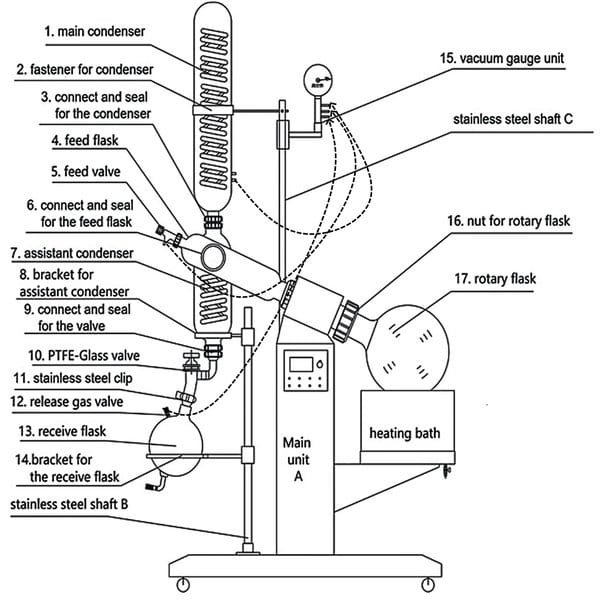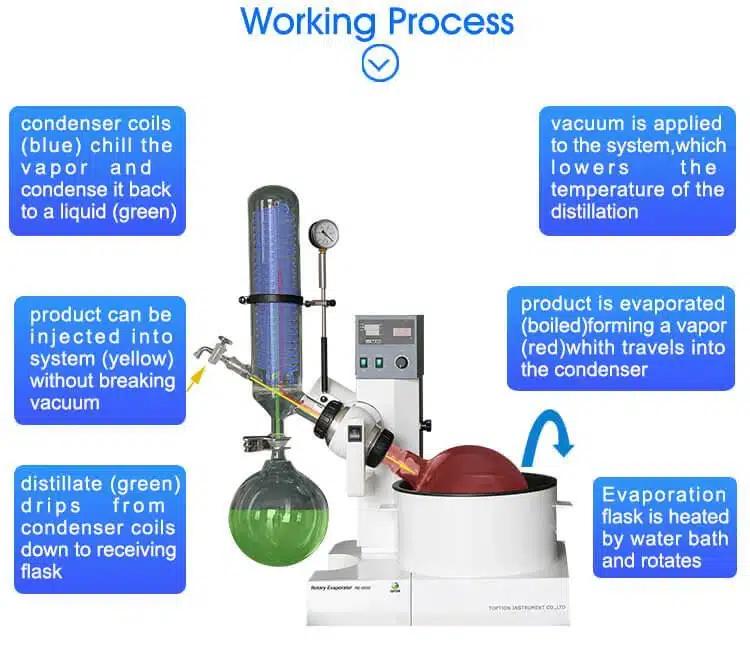The rotary evaporator, commonly known as a rotovap or rotavap, is an essential piece of equipment in modern laboratories and production facilities. It is a versatile instrument used for solvent removal and concentration processes.
Here, we understand the principles and proper operation of a rotary evaporator. We focus on essential components, advanced techniques, troubleshooting common issues, and optimizing rotary evaporator setups for specific applications.
Sections
ToggleUnderstanding the Rotary Evaporator

A rotary evaporator setup consists of several components; here are the key components:
- Evaporating Flask: A glass flask holds the sample solution and rotates within the heating bath.
- Heating Bath: It provides controlled heat to the evaporating flask. Usually, water or oil is used to heat the bath. Modern baths often feature digital temperature control for precise heating.
- Condenser: A coiled glass tube cooled by circulating water or another refrigerant. It condenses evaporated solvent back to liquid form.
- Vacuum Pump: It reduces pressure within the system, helping lower the boiling points of solvents.
- Receiving Flask: Collect the condensed solvent at the bottom of the apparatus.
How Rotary Evaporation Works
A rotovap uses the principle of reducing the pressure to lower the solvents’ boiling point. When a liquid’s vapor pressure equals the ambient pressure, boiling occurs. This temperature is significantly below the standard boiling points of solvents.
Also, rotary evaporation is more efficient due to the rotation of the evaporating flask, which increases the surface area of the liquid, accelerates evaporation, and prevents localized overheating or bumping.
Applications of a Rotary Evaporator

1. Chemical and Pharmaceutical Industry
- Solvent Removal & Purification: Rotary evaporator distillation is commonly used to remove solvents and extractives from reaction mixtures. It can isolate purified compounds without thermal degradation.
- Sample Concentration: Rotovapping allows precise concentration of dilute solutions to desired levels. Due to the gentle approach, it prevents sample loss and maintains composition integrity.
- Recrystallization Processes: Another benefit of rotovap setup is that gentle solvent removal facilitates controlled super saturation conditions. It is ideal for crystal formation.
2. Cannabis and Botanical Extraction
- Distillation of Cannabinoids: Making distillate with rotovap allows controlled vacuum and temperature conditions. It enables the separation of cannabinoids from terpenes without degradation.
- Solvent Recovery: The rotovap distillation process can recover solvents, reducing operational costs and minimizing environmental impact.
- Essential Oils & Botanical Extracts: Low-temperature rotary evaporator processing is helpful for extraction while preserving the volatile compounds in botanical materials. It maintains the aromatic profiles and bioactive properties of extracts.
Rotary Evaporator Set Up
- Arranging the Equipment
- Set the apparatus on a stable, level bench with adequate space around all components.
- Ensure proximity to water sources and drains.
- Place the vacuum pump in a well-ventilated area.
- Set up the chiller or cooling water circulation system within secured condenser connections.
- Connecting Components
- Attach the evaporating flask to the vapor duct using a Keck clip or fastener.
- Connect the vapor duct to the condenser.
- Secure the receiving flask to the bottom of the condenser with a clip or spring.
- Connect vacuum tubing from the condenser to the vacuum controller/trap and the pump.
- Vacuum System Check
- Inspect all O-rings and seals for cracks, wear, or contamination before assembly.
- Use quality vacuum grease on glass joints for an airtight seal.
- Install a cold trap between the rotovap and vacuum pump to protect the pump from solvent vapors.
- Perform preliminary vacuum tests to verify proper sealing.
- Temperature & Rotation Calibration
- Depending on the temperature requirement, fill the heating bath with appropriate fluid (water for temperatures <95°C, oil for higher temperatures).
- Set the bath temperature to 15-20°C above the desired flask temperature.
- Start rotation speed initially with 100-150 RPM, increasing gradually.
- Calibrate the vacuum controller for specific solvent’s properties.
Precision. Purity. Performance.
Rotary Evaporation Step-by-Step Process

Step 1: Preparing the sample and selecting the appropriate flask
Always choose a 2-3 times larger flask than your sample volume. Filter the sample to clean any particulates. Also, ensure the flask is clean, dry, and cracks-free.
Step 2: Secure the flask and start the vacuum application.
Attach the evaporating flask to the vapor duct and secure it with a clip. To reduce pressure, start the vacuum pump and slowly open the stopcock. This gradual approach is essential to prevent sudden boiling that can cause bumping or sample loss.
Step 3: Heating the bath and initiating rotation.
Start with a bath temperature about 10-20°C above the expected boiling point under vacuum. Turn on the flask rotation at a moderate speed (typically 100-150 RPM) and lower the flask into the heating bath.
Step 4: Monitoring solvent evaporation and collection.
As the rotovapping process continues, closely observe the condensation rate. The evaporation rate should be steady but not too vigorous. The process is optimized when a continuous condensate stream flows into the collection flask.
Step 5: Stopping the process and safely retrieving the distillate.
When there is no more visible condensation, raise the flask from the heating bath. Allow the system to rotate under vacuum for a few minutes to recover any remaining solvent vapors. Next, gradually release the vacuum to reach atmospheric pressure and stop rotation.
Step 6: Cleaning and maintaining the rotary evaporator for future use.
Clean all glassware with appropriate solvents to remove residues. Pay special attention to ground glass joints and remove old grease before applying fresh grease. Also, check vacuum seals for wear or damage.
Key Factors Affecting Rotary Evaporation Efficiency
1. Temperature control and bath settings
The temperature of the heating bath directly influences the evaporation rate. Optimizing it for each solvent and application is essential. If the bath temperature is too high, it can cause sample degradation, while too low temperatures can result in inefficient processing.
2. Vacuum pressure and its role in solvent evaporation
Vacuum pressure is one of the most critical parameters in the rotovap setup. The lower the pressure, the lower the boiling point of the solvent. Maintaining vacuum pressure at the right level maximizes efficiency while preventing sample loss.
3. Rotation speed and surface area enhancement
The rotation of the evaporating flask serves two critical purposes: it increases the surface area for faster evaporation and prevents bumping by distributing heat evenly.
4. Proper condenser function for maximum solvent recovery
The efficiency of the condenser determines the solvent recovery from vapors. Insufficient cooling leads to vapor loss, reduced recovery rates, and potential vacuum pump damage.
Best Practices for Using a Rotary Evaporator

1. Choosing the right flask size and solvent
Select an evaporating flask 2-3 times larger than your sample volume. Solvent properties are crucial, too, such as lower boiling solvents like diethyl ether or dichloromethane, which require larger flasks.
2. Avoiding foaming and bumping during evaporation
To prevent foaming and bumping, use anti-foaming agents. Adding boiling chips or stones can provide nucleation sites that help prevent superheating and sudden boiling.
3. Ensuring safety measures while handling volatile solvents
Always use a fume hood for rotary evaporator distilling flammable or toxic solvents. Ensure vacuum pumps have appropriate traps to prevent solvent vapors from reaching the pump oil.
4. Regular maintenance to prolong equipment lifespan
Implement scheduled maintenance. Clean all glassware immediately after use, regularly inspect vacuum seals, and periodically de-scale water baths and condensers to maintain optimal heat transfer efficiency.
Common Troubleshooting Issues and Solutions
1. Why Is My Rotary Evaporator Not Evaporating Properly?
If evaporation is slow or ineffective, consider the following:
- Vacuum Pressure Too High → Lower the vacuum to reduce the solvent’s boiling point.
- Bath Temperature Too Low → Increase the temperature within the safe range for the solvent.
- Flask Rotation Too Slow → Increase rotation speed to enhance surface area exposure.
- Solvent Choice → Ensure the solvent’s boiling point suits the vacuum and temperature settings.
2. Handling leaks in vacuum systems
If your rotovap setup fails to maintain proper vacuum, perform these checks systematically:
- Glass Joints Not Sealed → Apply fresh vacuum grease or PTFE sleeves.
- Damaged O-rings or Gaskets → Inspect for wear and replace cracked or deformed seals.
- Vacuum Hose Connections → Check all tubing for secured attachments, cracks, or holes.
- Vacuum Valve Issues → Clean or replace vacuum valves that may be stuck or contaminated.
3. Dealing with inefficient solvent recovery
If there is poor solvent recovery, examine these factors:
- Condenser Temperature Too High → Ensure the cooling agent is cold enough for effective condensation.
- Vacuum Release Too Rapid → Always release the vacuum slowly to prevent uncondensed vapors.
- Condenser Contamination → Clean the internal condenser surfaces to improve thermal transfer.
- 4. How to prevent overheating or underperformance
To handle common temperature-related issues:
- Uneven Heating → Ensure appropriate bath fluid level and flask is immersed to the correct depth.
- Temperature Sensor Calibration → Verify and calibrate bath temperature sensors for accuracy.
- Inappropriate Bath Fluid → For <95°C applications, use water, and for higher temperatures, use fluids like silicone oil.
Conclusion
A rotary evaporator is a sophisticated setup but a versatile instrument enabling efficient, gentle solvent removal while preserving the integrity of sensitive compounds. Understanding rotovapping principles and following proper procedures ensures optimal results, extends equipment lifespan, and maintains a safe working environment.




